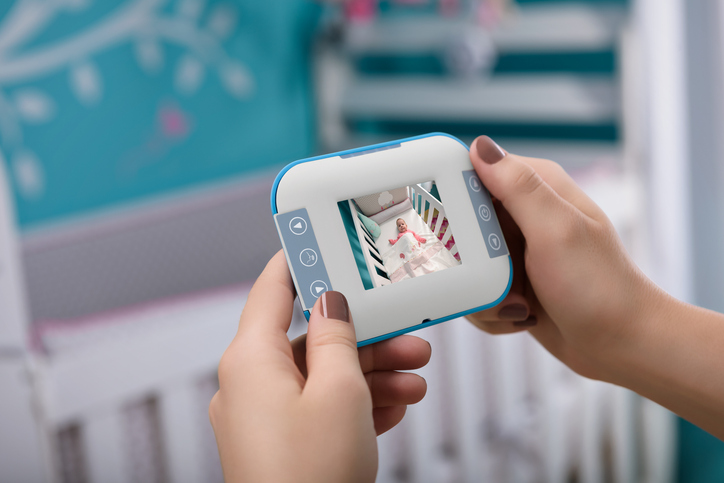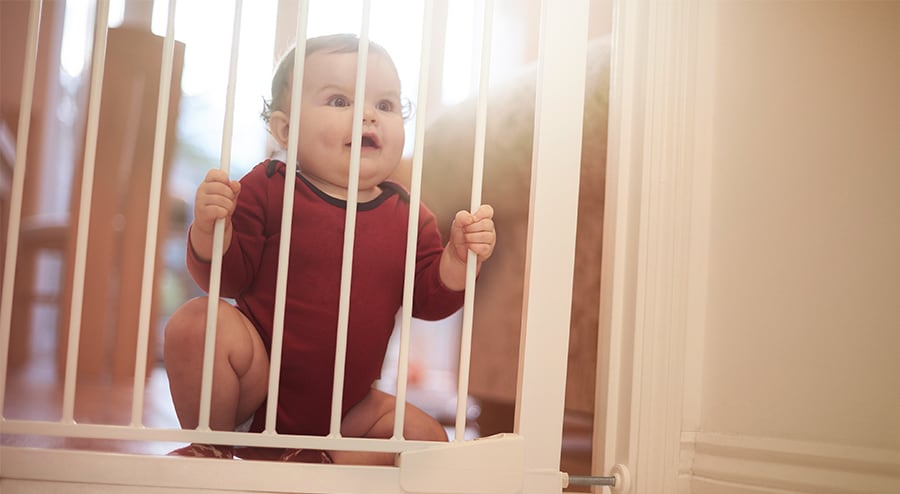Baby monitors have become an indispensable tool for modern parents, offering a sense of security and peace of mind for their children. With the advancements in technology, baby monitors now come equipped with various features like video streaming, temperature sensors, and even internet connectivity for remote access. While these innovations have enhanced convenience, they have also raised concerns about the safety and privacy of these monitoring systems.
Parents who understand encryption methods and secure data storage when addressing potential hacking risks can create a secure and private monitoring environment of the utmost safety and ensure the well-being of their infants. By prioritizing baby monitor safety, parents can confidently navigate the digital landscape and provide their infants with the care and protection they deserve.

Encryption Methods for Data Security
Data encryption is a key feature of a secure baby monitor. Encryption encodes the video and audio streams transmitted between the camera and the receiver, making it difficult for unauthorized individuals to intercept and access the data. End-to-end encryption is particularly desirable, as it ensures that the data remains encrypted throughout its entire journey, from the camera to the viewing device.
Two-Factor Authentication and Login Security
A two-factor authentication can be utilized for the baby monitor’s login process to further enhance security. This means that after entering the password, an additional verification code or token is required to gain access. Two-factor authentication adds an extra layer of protection, preventing unauthorized access even if the password is compromised.
Non-Internet Connected Baby Monitors for Added Security
Baby monitors that do not rely on internet connectivity offer an extra level of security. Non-internet connected monitors operate through closed-circuit systems, meaning they do not transmit data over the internet, reducing the risk of potential hacking or external interference. These monitors function within a localized network, providing peace of mind for parents concerned about data privacy.
Reliable Brands Known for Secure Monitoring Systems
When choosing a baby monitor, opting for a reputable and trustworthy brand known for its commitment to security is crucial. Reliable brands invest in research and development to continuously improve security features, ensuring that their products comply with safety standards and industry best practices.
Recommended products for secure baby monitoring include the Nanit Pro Smart Baby Monitor, known for its end-to-end encryption and advanced security measures. Additionally, the Arlo Baby Monitor offers two-factor authentication and local storage options, providing parents with added peace of mind. Investing in these reliable brands and their secure monitoring systems can significantly enhance the safety and privacy of baby monitoring, giving parents the confidence they need to keep their little ones safe and protected.
Setting Up a Secure Baby Monitor
There are some things to take into consideration when creating a safe monitoring space. For instance, establishing a secure Wi-Fi connection, regularly updating the monitor’s firmware, and addressing physical security issues all contribute to setting up a secure space.
Establishing a Secure Wi-Fi Connection and VPN Usage
Ensuring security when setting up a baby monitor begins with establishing a secure Wi-Fi connection. Make sure your home network is password-protected with a strong and unique password, avoiding common or easily guessable phrases. It is advisable to use WPA2 or WPA3 encryption protocols for added protection.
For an extra layer of security, consider using a Virtual Private Network (VPN) when accessing the baby monitor remotely through a smartphone or computer. A VPN encrypts your internet connection, safeguarding data from potential eavesdroppers and unauthorized access. Various VPN services are available, with monthly subscription costs ranging from $5 to $15, depending on the provider and plan.
Regular Firmware Updates for Continued Security
Keeping the baby monitor’s firmware up to date is important for maintaining its security. Manufacturers often release firmware updates to address potential vulnerabilities and improve the monitor’s overall performance. Regularly check for updates through the manufacturer’s website or the accompanying app and follow the instructions provided to install them.
Failure to update the firmware could leave the baby monitor susceptible to security breaches, as hackers may exploit known weaknesses. Timely updates, on the other hand, ensure that the monitor’s security remains up-to-date and effective.
Safeguarding Against Physical Tampering and Unauthorized Access
Physical security is equally important when it comes to baby monitor safety. Place the monitor’s camera in a location that is out of reach of children and potential intruders. Securely mount the camera to avoid it being dislodged or tampered with. Additionally, regularly check the monitor’s settings and passwords to ensure that only authorized users have access.
For baby monitors with internet connectivity, change the default login credentials to unique and strong passwords. Avoid using easily guessable information, such as birth dates or common words. Instead, create a password with a mix of upper and lower case letters, numbers, and special characters.
By following these measures during setup, parents can create a more secure and reliable monitoring environment, ensuring the safety and privacy of their little ones.
Privacy Concerns, Interference Prevention, and Data Handling
Some other considerations parents might take into account concerns addressing privacy issues, implementing secure data transmission and storage methods, and prioritizing data protection from their baby monitors.
Risks of Smartphone App Baby Monitors
Smartphone app baby monitors offer convenience and accessibility, but they also come with certain privacy risks. As these apps often require access to a smartphone’s camera and microphone, there is a possibility of sensitive data being mishandled or accessed by unauthorized individuals. To mitigate these risks, it is crucial to choose reputable baby monitor apps developed by well-known and trusted companies.
Parents should carefully review the app’s privacy policy to understand how their data will be used and stored. Opt for apps that employ strong encryption methods for data transmission, ensuring that video and audio streams are secure and inaccessible to outsiders. Additionally, using dedicated devices for the baby monitor app, rather than everyday smartphones, can further reduce the risk of potential data breaches.
Ensuring Privacy with Video and Audio Streaming
Video and audio streaming are essential features of modern baby monitors as they provide parents with real-time insights into their child’s well-being. However, the transmission of video and audio signals can potentially be intercepted if not adequately protected. To ensure privacy, opt for baby monitors that use secure encryption methods for data transmission, as discussed in section II(A).
Some baby monitors offer additional features like end-to-end encryption, which further enhances data security by ensuring that the data remains encrypted throughout its entire journey from the camera to the receiver. Products such as the Arlo Baby Monitor and Nanit Pro Smart Baby Monitor provide end-to-end encryption for secure video streaming.
Secure Methods of Data Storage and Protection
Be sure that the sensitive information collected by baby monitors is stored securely. Secure methods of data storage often involve encryption and robust security protocols. Look for baby monitors that use end-to-end encryption to safeguard video and audio streams from the camera to the receiver, making it difficult for unauthorized parties to access the data.
Some baby monitors provide local storage options, such as a secure microSD card slot or a removable storage device, allowing parents to retain control over their data without relying on external cloud services. Additionally, manufacturers may offer encrypted cloud storage as an option for secure data backups, provided that the cloud storage service follows strict security measures.
Addressing Hacking and Compromised Monitors
Information is not always safeguarded against hacking. Be sure to look for signs of a hacked monitor and be ready to implement methods against the invasion of privacy.
Signs of a Hacked Baby Monitor
Detecting a hacked baby monitor should be something parents are aware of. Some common signs of a compromised baby monitor include unexplained movements of the camera, strange noises, or sudden changes in the monitor’s settings. If you notice any unfamiliar activity or behavior from the monitor, it could be an indication of unauthorized access.
Additionally, if your monitor uses an app for remote viewing, be vigilant for any unauthorized logins or devices accessing the app. These signs may suggest that someone has gained access to your baby monitor’s video feed and could be potentially spying on your family.
Immediate Steps to Take if Suspected Hacking
If you suspect that your baby monitor has been hacked, take immediate action to secure your family’s privacy by disconnecting the monitor from the internet or Wi-Fi network to prevent further unauthorized access. Additionally, change the monitor’s login credentials, including the username and password, to something strong and unique.
Next, contact the baby monitor manufacturer’s customer support or technical assistance for guidance on how to proceed. They may be able to provide specific steps to secure the monitor and investigate any potential security breaches.
Reliable Sources for Safety and Security Testing
Organizations like Consumer Reports and independent technology review websites often conduct thorough assessments of baby monitors and other child safety products. These evaluations include testing the devices for vulnerabilities and potential security risks and are reliable checks for safety standards.
By consulting these reliable sources, parents can gain valuable insights into the best-performing baby monitors that meet stringent safety and security standards. Pay attention to reviews and recommendations from experts who prioritize privacy and data protection, as their assessments can guide you in making an informed choice when selecting a secure and reliable baby monitor for your family.
Addressing potential hacking risks and staying informed through reputable sources can help parents maintain the integrity and safety of their baby monitoring system.
Alternatives to Traditional Baby Monitors
While traditional baby monitors offer reliable monitoring solutions, there are alternative methods available to meet different parenting needs which should be researched when purchasing monitoring systems. Furthermore, it is important to understand the needs and requirements of your home and family when comparing monitors and camera systems.
Other Methods for Monitoring Baby’s Safety
An alternative option to traditional monitors is the use of audio-only baby monitors, which transmit sound without video. Audio monitors can be cost-effective and are ideal for parents who prioritize simplicity and want to listen for their baby’s cries or sounds without the need for video streaming.
Another alternative is the utilization of smart home devices, such as smart cameras or smart speakers, to monitor the baby’s room. Smart cameras equipped with night vision and two-way audio capabilities can provide real-time video and audio monitoring through smartphone apps. Additionally, smart speakers with intercom features can enable parents to communicate with their baby from other rooms.
Comparison of Dedicated Monitors vs. Home Security Camera Systems
Dedicated baby monitors and home security camera systems each offer different features that cater to certain preferences and requirements. Dedicated baby monitors are designed specifically for monitoring infants and often come with specialized features like temperature sensors, lullabies, and night lights. They usually provide a closed system with secure video and audio streaming, ensuring a focused and private monitoring experience.
On the other hand, home security camera systems offer more versatility beyond baby monitoring. They provide broader surveillance capabilities for monitoring multiple areas of the home. Some parents prefer home security camera systems because they can serve dual purposes, enhancing home security while also monitoring their baby. However, it is essential to ensure that the chosen home security camera system prioritizes data security and offers end-to-end encryption for baby monitoring.
Ultimately, the decision between dedicated baby monitors and home security camera systems depends on individual preferences, budget, and the desired level of monitoring. Whichever option parents choose, ensuring the selected device adheres to safety standards and offers reliable security features is paramount to ensuring the safety and well-being of their baby.
Take Away
Prioritizing baby monitor safety through strong encryption, two-factor authentication, and regular updates ensures a secure monitoring experience. Being cautious about app permissions and considering reputable brands with safety certifications are essential. Parents can confidently monitor their infants, creating a safe and reliable environment for their little ones.




